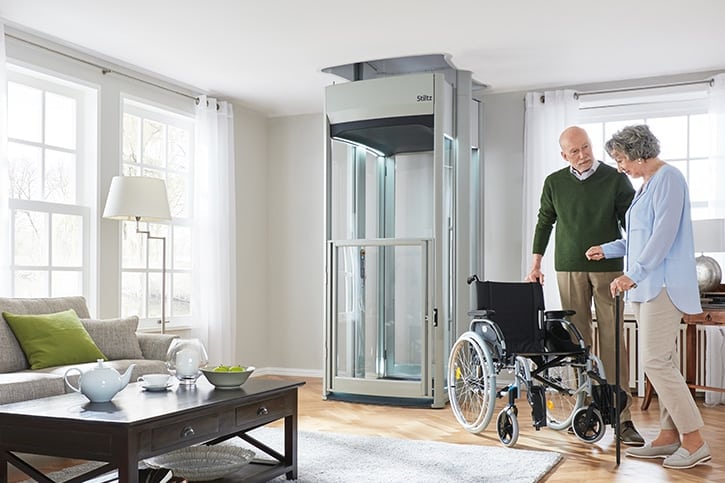Discover practical tips and adaptations to make your home safer and more comfortable for those living with dementia.
Simple Dementia-Friendly Home Ideas

How To Make Your Home Dementia-Friendly: Practical Tips For A Safer Environment

As we grow older, staying in a familiar environment can be comforting, with 78.4% of 60-99-year-olds saying they would prefer to continue living at home as they age. For those with dementia, staying in the house they know and love is more than just a comfort. It can also help to reduce their levels of confusion and improve overall wellbeing.
However, you may find that your home needs some adjustments to make it more suitable for those with dementia and Alzheimer’s — particularly to ensure it’s safe to live in as the condition progresses. In fact, 65% of all hospital admissions for dementia patients each year are the result of infections or injuries that could’ve been prevented with the right adjustments.
We’ll introduce you to some practical steps and home adaptations that can make your home safer and more comfortable for someone living with dementia.
Why are home adaptations important for dementia patients?
Over 944,000 people in the UK are currently living with dementia, and around two-thirds of them choose to remain at home rather than move into an assisted facility. But as the condition develops, everyday tasks can become more difficult, which is why it’s essential to make adjustments at home to keep everyone safe and comfortable.
Let’s explore the physical and psychological benefits that making adaptations to your home can provide:
Physical benefits
Dementia is a complex condition that can present various physical symptoms, including:
- Confusion
- Memory loss
- Mobility issues
- Difficulty with speech
- Loss of balance
- Visual impairment
- Hearing loss
As these symptoms progress, it becomes more challenging for individuals to move around safely within their homes. Daily tasks can become overwhelming without proper adjustments, increasing the risk of falls, accidents, and injuries.
Tens of thousands of dementia patients are admitted to hospitals across the UK each year.
The good news is that simple adjustments can help to limit these risks. By making your home safer, you not only reduce the likelihood of serious accidents but also help avoid the confusion and stress that comes with hospital visits, which can be particularly unsettling for someone living with dementia.
Psychological benefits
Staying in a familiar home can also have a positive impact on the mental and emotional wellbeing of those living with dementia. Studies have shown that dementia patients who continue living at home tend to have a significantly higher quality of life compared to those in care facilities, regardless of the severity of their condition.
Remaining in a familiar setting can help reduce anxiety and confusion, as these surroundings can be comforting and promote a sense of security. This, in turn, enhances the patient’s overall well-being. Staying at home also allows people with dementia to maintain a greater sense of independence; they can make choices about their daily routines, which can foster a sense of control and dignity.
This can also be beneficial from a social perspective as it allows those with dementia to continue enjoying connections with family, friends, and their local community. These social interactions can be crucial for the patient’s mental health and emotional support, which can often be more difficult to maintain in a care home setting. At home, the level of care can also be tailored more specifically to the individual’s needs and preferences. For example, caregivers can provide one-on-one attention, focusing on activities and routines that the patient engages with and enjoys.
What is a dementia-friendly environment?
Creating a dementia-friendly environment is about building a space that enhances the safety, independence, and comfort of the person who has been diagnosed. The main goal is to make living in the home as easy as possible by keeping everything simple and easy to reach, while also providing the necessary support as the condition progresses.
Some key characteristics of these environments include using clear signage, suitable lighting, reduced clutter, and familiar design elements that aid navigation and reduce confusion.
Transforming your home into a dementia-friendly environment has multiple benefits:
- Enhanced safety — These environments incorporate features that minimise risks of accidents, such as slips and falls. For example, you may choose to install non-slip flooring, secure handrails, and clear pathways, which can help create a safer living space for people with cognitive impairments.
- Improved orientation and mobility — Clear signage and visual cues (like colour-coded pathways or landmarks) can help those with dementia navigate their surroundings with ease. This enhancement helps to encourage independence and reduces the frustration that can be associated with disorientation.
- Increased engagement and quality of life — A well-designed environment should encourage the person with dementia to participate in activities and social interaction. By creating inviting spaces, these environments can enhance overall well-being and help to provide a sense of purpose.
Kitchen adaptations
The kitchen is often one of the most challenging areas of the home for someone with dementia. It’s a space where everyday tasks like cooking and making drinks can become overwhelming, especially with memory loss, confusion, or difficulty with mobility.
Here are a few practical kitchen adaptations to consider:
- Keep frequently used items easily accessible — Place mugs, tea/coffee, and spoons on the worktop, where they’re easy to reach.
- Replace solid cupboard doors with clear ones — This makes the contents easy to see, reducing the need for rummaging and confusion.
- Use simple signs or photographs — Label cupboard doors with photos of the items inside, providing a visual cue to make it easier to find what you need.
- Mark hot and cold taps — Use clear labels on taps or replace them with colour-coded taps indicating which is hot and cold, preventing confusion and burns.
- Write simple appliance instructions — For items like microwaves or washing machines, place easy-to-read instructions next to the appliance to help with daily use.
- Replace pans — It’s a good idea to replace any metal-handled pans with plastic-handled alternatives, as the metal can get dangerously hot.
Bedroom adaptations
The bedroom is one of the most important areas of the home when it comes to making your home suitable for someone with dementia. As the condition progresses, this can lead to sleep disturbance, more frequent confusion, or difficulty with daily tasks like getting in and out of bed. Making the bedroom a safer environment is key to reducing the risk of accidents.
Here are some helpful bedroom adaptations to consider:
- Use a movement sensor or bed sensor — These devices can alert a family member or caregiver if the person gets out of bed, which can be especially helpful if they tend to wander at night.
- Fit a waterproof mattress cover — If the person with dementia has continence issues, a waterproof mattress cover can help protect the bed.
- Choose appropriate bedding for the season — Bedding should be switched out as the weather changes to make sure the person isn’t too hot or too cold. This can help reduce the amount of waking during the night.
- Install a nightlight or touch-operated bedside light — A light near the bed that’s easy to turn on or off can be a lifeline for someone who gets up in the middle of the night, reducing confusion and risk of falls.
Bathroom adaptations
Bathrooms are another area in the home that can present unique challenges for people with dementia, and due to the risks associated with running water and slippery surfaces, it’s crucial to make sure these spaces remain safe for everyone living there.
Here are some practical bathroom adaptations to consider:
- Place signs or pictures on the bathroom door — Use a simple image of a toilet on the door to make it easy to identify the bathroom.
- Leave the bathroom light on at night — A dim light can help to guide the person if they need to get up in the night. Using energy-efficient bulbs here can also help keep electricity bills low.
- Choose a contrasting toilet seat — Using a toilet seat and lid in a different colour from the rest of the toilet makes them easier to spot, which can help those with visual impairment.
- Remove toilet and bath mats — Mats can be a trip hazard or may even look like holes in the floor for someone with dementia, so it’s best to remove them.
- Consider using a free-standing toilet roll holder — These are easier to see in comparison to a wall-mounted style. Placing it next to the toilet removes the need to stretch and reduces the risk of losing balance.
- Install grab rails — Adding rails or handles at key points, such as next to the toilet and in the bath/shower, provides support and prevents falls.
- Use flood prevention/scald resistant plugs — These prevent the risk of burns by changing colour when the water is getting too hot, and can offer peace of mind to caregivers.
Living-room adaptations
People spend a lot of time in the living room, and for individuals with dementia, this space needs to be safe and comfortable. The key to dementia-friendly living is ensuring the person feels at ease and can move about without risk of injury. This can be achieved through thoughtful changes that focus on comfort, safety, and familiarity.
Here are some helpful tips for adapting the living room:
- Comfortable furniture — Opt for furniture that’s easy to sit on and stand up from. You might also want to consider assistive chairs that rise, lower, and tilt to help the person get up with less effort.
- Family photos and memory aids — Display family photos with labels to help the person feel grounded and connected to their loved ones. These can act as visual cues to help trigger memories.
- Keep important items within reach — Place frequently used items like glasses, mobile phones, or remote controls in a consistent, easy-to-reach place.
- Simple TV remote controls — If the person struggles with remote controls, using universal remotes with large buttons or simplifying the existing remote by covering unnecessary buttons with tape can be helpful.
- Avoid electric fires or portable heaters — These can be a hazard, as they may be left on accidentally or tripped over. It’s safer to avoid using them or use fixed, safer alternatives.
Moving through the home
For people living with dementia, getting around the house can become increasingly difficult due to mobility issues and a lack of balance.
Here are some practical tips to make movement easier:
- Keep hallways uncluttered — Clear paths make it easier for people with dementia to get through doorways and move between rooms. Make sure furniture isn’t blocking walkways, and remove anything that could cause a trip hazard.
- Use gripper tape on rugs — Rugs and carpet runners can easily slip and cause falls. Securing them with gripper tape or removing them altogether can help to prevent accidents.
- Install a home lift — For those who have particular difficulties navigating stairs, a home lift can be an excellent solution. Not only does it help avoid the risks associated with climbing stairs, but it also allows quick and easy movement between floors, giving individuals with dementia more freedom.
Dementia-friendly home decoration ideas
Creating a dementia-friendly home isn’t just about making sure the space is functional — it also needs to feel homely. If you’re relocating to a new property, making conscious decorating choices can improve the lives of everyone involved.
If the person with dementia is continuing to live in a home they’re already familiar with, these changes may need to be more subtle. If the patient has lived in their current home for a long time, they may react better to leaving everything as it is when it comes to wall colours and carpets, as bigger changes to a familiar environment could cause more confusion. However, things like rugs should be moved to reduce trip hazards.
For new environments, minor adjustments to the types of decoration used can help reduce confusion, anxiety, and improve independence for everyone living in the home:
- Keep patterns neutral — Rugs, carpets, or wallpaper with repetitive or busy patterns can be very disorienting for someone with dementia and can increase their feelings of confusion. Instead, try to opt for simple designs with contrasting colours, which are often much easier to navigate and create a clearer environment.
- Use contrasting colours — This can include painting walls a different colour from the floor and highlighting doorframes with coloured tape, as this can help people with dementia see and recognise key spaces more easily.
- Avoid dark rugs — These can sometimes look like holes in the floor, which can be a safety risk as the person with dementia might try to jump over them and injure themselves. Stick to light, solid colours that don’t blend with the floor, and ensure they’re secured in place to avoid tripping hazards.
Funding your home modifications
If you live with someone who has dementia, especially in a multi-generational household, you’ll naturally want to adapt your home to make it as safe and comfortable as possible. However, the cost of making these changes can sometimes feel overwhelming. The good news is, there are financial options available to help make these adjustments more affordable.
The Disabled Facilities Grant (DFG) offers up to £30,000 to cover home modifications, such as widening doorways, installing ramps, or adding a home lift. It’s worth checking if you’re eligible, as it can significantly ease the financial burden.
Create a comfortable environment with Stiltz
If you plan to make your home dementia-friendly, a home lift can help provide easy, safe access between floors and make movement through the home easier for those with mobility issues.
Discover the Stiltz range, including the Trio model, designed for wheelchair users or those needing extra space. Contact us today to learn more about choosing the right lift, or see our blog for more inspiration on ageing in place.
Customer Testimonials
My experience with Stiltz Homelifts. Just over a month ago, I had my Stiltz lift installed and I am so pleased with it. The workmen that came and fitted it were very professional and knew what they were doing. They were so professional I would not hesitate to recommend Stiltz lifts to anybody.
Excellent from beginning to end – and beyond.
Everybody we dealt with at Stiltz was very helpful and efficient, from the initial meeting with Nick Sale, the sales rep, thorough technical inspection, the builders, installers, plumber, electrician, and excellent follow up service and attention. My husband’s life is transformed and mine is much easier. Thank you Stiltz.
An excellent company from the first contact to the completed project. All personnel were friendly and very polite but stayed extremely professional throughout. Having been in the construction industry for over 40 years I was aware the preparation work was carried out to a high standard by the best of trades people. The lift itself can not be faulted both the operation and aesthetics.
The service was better than 1st class. It was excellent in every way. We could not be more pleased with everything Stiltz applied it’s self to in any way. We would award 6 stars at the very least.
Suggested Articles
Five Reasons Why Home Lifts Are Better Than Stairlifts
Home lifts are a modern alternative to stairlifts, offering reliability, speed, capacity, and seamless aesthetic integration for a stylish and efficient solution.
How A Disabled Facilities Grant Can Help You Own A Home Lift
Disability Facilities Grants, up to £30,000, can fund home adaptations like Stiltz lifts, supporting independent living for disabled individuals.
What Happens If There Is A Power Cut And I Am In The Home Lift?
Power cuts can be unpredictable. Here’s what you need to know about using your home lift when the lights go out.






